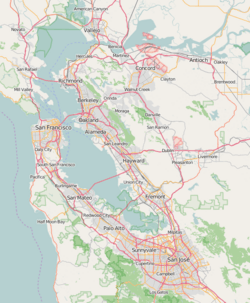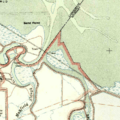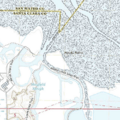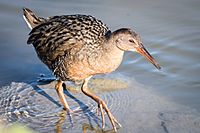Hooks Island facts for kids
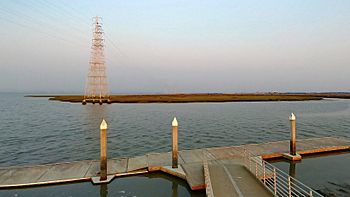
Hooks Island as viewed from the Palo Alto Baylands Sailing Station in September 2020
|
|
| Geography | |
|---|---|
| Location | Northern California |
| Coordinates | 37°27′22″N 122°05′51″W / 37.45611°N 122.09750°W |
| Adjacent bodies of water | San Francisco Bay |
| Total islands | 1 |
| Area | 36 acres (15 ha) |
| Administration | |
|
United States
|
|
| State | |
| County | Santa Clara |
| City | Palo Alto |
Hooks Island is a special island in the San Francisco Bay in Palo Alto, California. It is about 36 acres big, which is like 27 football fields! This island is a salt marsh, meaning it's a wetland that gets covered by ocean water during high tides.
Hooks Island is a safe home for many endangered species. It also has five tall towers that carry electricity lines. A report from 2020 called it a "peaceful tidal salt marsh." This means it's a natural wetland where the tides come in and out. The very top of the island is called Hooks Point. You can find Hooks Island just east of the Palo Alto Baylands Sailing Station.
Because it's part of the Palo Alto Baylands Nature Preserve, Hooks Island is a protected area. This means people are not allowed to visit it. Also, new buildings or homes are not allowed to be built there. This helps keep the island wild and safe for its plants and animals.
-
USGS map from 1899.
Contents
Plants of Hooks Island
Just like many places, grass grows on Hooks Island. Special types of grass called cord grass grow here. These grasses are very important because they create a home for many animals.
The Problem with Invasive Grass
In 1997, scientists found a problem. A native cord grass, called Spartina foliosa, was being pushed out by an invasive grass. This new grass, Spartina alterniflora, came from somewhere else. It grows much thicker than the native grass. This makes it hard for animals to move around.
This invasive grass was first brought to the area in 1973. The United States Army Corps of Engineers wanted to use it to stop erosion and help the marshes. But the S. alterniflora mixed with the native grasses. It grew very dense both above and below the ground. This pushed out animals that lived on the surface and those that lived in the mud.
Saving the Native Grasses
When people realized the new grass was hurting wildlife, they decided to fix the problem. The San Francisco Estuary Invasive Spartina Project worked to remove the harmful grass. They used a special plant killer called imazapyr and also removed the grass by hand.
This project was a big success! In 2005, the invasive grass covered 805 acres. By 2016, it was down to only 28 acres. However, officials later asked them to stop removing all of it. This was because the Ridgway's rail, an endangered bird, had started living in the thick patches of the invasive grass.
Animals of Hooks Island
Many birds live on Hooks Island. One important bird is the Ridgway's rail, which is a near-threatened species. This means it's close to becoming endangered.
Ridgway's Rail Population
In 2011, a report found about 14 Ridgway's rails in the Baylands area. It also said that 19 of these birds were known to live at Palo Alto Harbor and Hooks Island. Other guesses for the total number in the Baylands in 2011 were between 15 and 29 birds. In 2010, there were as many as 22 Ridgway's rails.
Feral Cats and Wildlife
In 2013, some people worried that feral cats (wild cats) were living on Hooks Island. They thought these cats might be harming the Ridgway's rails. It's true that there are many cats in the San Francisco Bay Area. But people disagreed about how many were in the Palo Alto Baylands. They also disagreed about how much harm the cats were doing to the birds.
A city manager said they had seen wild cats hunting birds in the Baylands Nature Preserve. But a volunteer from the Palo Alto Humane Society said that the harm caused by wild cats was small compared to other problems.


